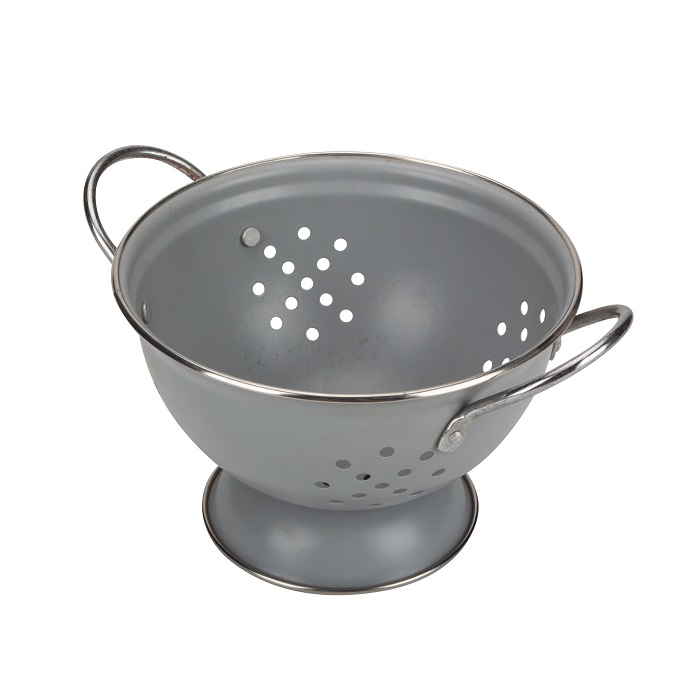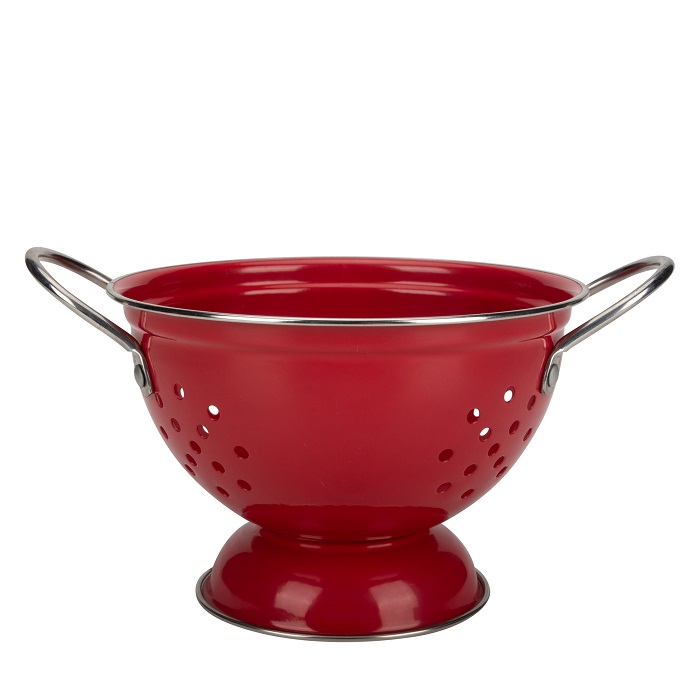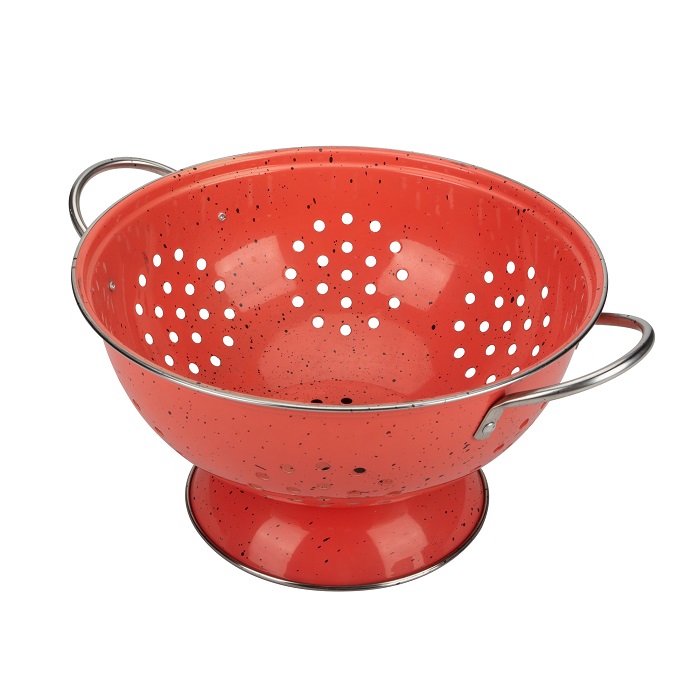The current situation and development trend of children's clothing industry
We're own factory for professionally producing Enamel steel colander with customized logos and customerized colors.
Our Metal colanders are made from galvanized steel and tinplate materials, which are durable and eco-friendly, withstanding the test of time, we can use enamel color coated on the finishing to make it enamel looking.
Besides, our hot sale colanders can be designed with the steel edge and customized decal patterns.
Comparing to other similar manufacturers, we produce vegetables and fruits colanders with more competitive in prices, durable in quality.
We sell enamel steel products to European, North America.
We have produced many different designs, which can be suitable for different customers with different styles and in various regions.
Colander Enamel steel colander, Metal colanders, colanders, vegetables and fruits colanders, enamel steel products Jiangmen Kimleyda Hardware Co., Ltd , https://www.kldmetalware.com In 2012, the clothing industry can be found to have the following characteristics: First, weak domestic and international market demand, growth slows down; Second, the domestic competition pattern changes, the market depth breakdown; Third, the traditional profit model is challenged, the new marketing model diversification; Fourth, the two-way expansion of sales channels, the brand break through steadily.
In 2012, the clothing industry can be found to have the following characteristics: First, weak domestic and international market demand, growth slows down; Second, the domestic competition pattern changes, the market depth breakdown; Third, the traditional profit model is challenged, the new marketing model diversification; Fourth, the two-way expansion of sales channels, the brand break through steadily.
It is undeniable that the domestic apparel industry has encountered great difficulties in its development in 2012. The children’s clothing industry, which is an important component of the industry, has not been able to stand alone. There are children's clothing entrepreneurs who think that although the development of the industry is facing difficulties, it is still developing. It depends on how you think about difficulties and development. Indeed, since difficulties are unavoidable, companies must learn to deal with it calmly, sum up lessons learned, and grasp their own development direction.
Children Clothing Industry Development Status At present, China has more than 10,000 children's wear enterprises. Industry clusters are mainly distributed in Dongguan, Guangdong, Huzhou, Zhejiang, Quanzhou, Fujian, Anyang, Henan, and Chengdu, Sichuan. The annual output of children's wear is about 5 billion pieces, of which domestic sales are about 2 billion. Pieces, total sales of about 100 billion yuan.
For the past 2012, summing up the development of the children's wear industry can be found in the following characteristics:
First, weak domestic and international market demand, growth slowed down. Since 2012, the total number of garment exports in China has continued to decline for several months, the growth rate of export value has continued to decline, and the downward trend of children's clothing exports has become more apparent. Take woven baby clothes and accessories as an example. From January to September 2012, the number of exports and the amount of exports showed a double-digit negative growth, with the number of exports falling by 29.87% year-on-year, and the amount of exports falling by 19.04% year-on-year.
After spending several years of rapid growth, the consumption of children's clothing in the domestic market began to stabilize at the end of 2010, but it fell steadily. According to statistics from the China National Business Information Center on large-scale retail business enterprises, in October 2010, children's wear sales continued to increase by more than 10%, while in December 2010, children's wear sales increased by 7.28% year-on-year. By the end of 2011, the increase in sales of children's wear was reduced. 4.30%, from January to August 2012, the increase in sales of children's wear was only 4.05%. At the same time, the cumulative increase in the number of various types of clothing sales is only 0.53%. Of the 13 categories of apparel products collected by the China National Business Information Center, sales of 6 categories of products had a negative growth of more than 2%, sales of category 4 products were only positive growth of about 1%, sales of only two categories of products increased by more than 4%, and children's wear Domestic sales can be described as "outstanding."
The second is the change of domestic competition and the deep market segmentation. After a period of development, the pattern of competition in the children's wear industry is relatively stable, and brand echelons formed from multiple levels, such as regions, grades, and style types, have begun to appear. However, with the change in consumer demand and the increasingly complex competition, the competitive landscape has quietly changed. Market competition pressure has accelerated the advent of a deeper segmentation of the children's wear market. This kind of market segmentation is not limited to age, grade, region, but also in terms of personality, preferences, and functions. Market segmentation created new market opportunities, and also broke the original competitive landscape and narrowed the market space for each brand. According to statistics from the National Business Information Center of China for key large-scale retail enterprises in the country, the top ten brands of children's clothing sales in 2011 were less than 30%, which was a year-on-year decline of 1.73 percentage points.
In fact, due to the influence of the external macro environment, the entire Chinese manufacturing industry is now facing greater difficulties. The environment, development conditions, industrial development factors, and consumers facing the domestic children's wear industry are also undergoing profound changes. The Chinese children's wear industry has indeed reached a stage of this transformation.
Third, traditional profit models have been challenged and new marketing models have been diversified. At present, under the pressure of rising raw materials and labor costs and rising commercial costs, the profit model of children's clothing enterprises has been severely challenged. Many brands and companies are innovating profit models through innovative marketing models. In addition to the traditional department stores, brand stores, chain stores, and large-scale living halls, some innovative marketing models are gradually being accepted by consumers, and there is a rapid growth trend. For example, online marketing, animation and cartoon marketing, charity marketing, multi-brand portfolio marketing, and other new marketing models such as online and offline marketing are gradually emerging.
As far as online marketing is concerned, in 2012, the well-known children's wear brand Shui Hai Er started to e-commerce. Chairman Cao Shengkui said: "In order to grasp the market opportunities for the rise of e-commerce in the past two years, we have conducted detailed investigations and plans from various aspects. After comparison with online and offline competitors, Shui Haier decided to start a vigorous effort from 2012. Conduct e-commerce.†He also believes that the long-standing reputation of the physical store manager has abolished the customer's buying concerns, and the online store has opened up the geographical limitations of the physical store. With the popularization of network construction, the emergence of the 4+2+1 family model (four elderly people and parents supporting a child), and the shrinking differentiation of cities and towns, brand children's clothing, especially online business, has a large space for development and can be used as children's clothing. The main attack market for brand development terminal network builds the foundation for sustainable development of brand management and brand market share.
The fourth is the two-way expansion of sales channels, and the brand breaks through steadily. China's urbanization is accelerating. The awareness of branding of children's wear in small and medium-sized cities is accelerating. There is a clear trend of consumption upgrading in the second, third and even fourth-tier markets. Domestic brands with high reputation in the first and second-tier markets have more advantages in achieving rapid sinking and intensive penetration of sales channels in the third and fourth-tier markets. The first and second-tier children's clothing brands have already begun to be deployed in third and fourth-tier cities. At the same time, some brands that have a certain foundation in the third and fourth-line markets have begun to use multiple channels and various means to penetrate the first-tier and second-tier markets.
The trend of children's wear industry development is that the industry structure has gradually become three-dimensional. Product subdivision, brand positioning, marketing model, market channels and formats, etc. Each layer will be subdivided, which will enable the children's clothing industry to gradually develop from flat to three-dimensional, with various marketing models, different scales, and engaging in various sub-industry industries. In the horizontal industry chain, there are vertical chains such as leading brand enterprise groups, regional market brands, processing enterprises, and industrial clusters, with capital, design, professional markets, and marketing teams interspersed among them.
The second is the trend of multi-brand and group development. With the deep subdivision of the domestic children's wear market, the sustainable development of multi-brand conglomeration has become a trend. The efficient integration and effective control of all kinds of upstream and downstream children's clothing resources across the country and even in the world can be continuously subdivided. China Insurance has a higher market share. At the same time, China's children's wear brands will also receive more and more extensive business development opportunities, and more "commercialized" companies such as brand-integrated stores, spa models, and buyers will be created.
Take the brand integration shop as an example. In this year's "China's top ten children's wear brand salon entrepreneurs," Beijing Jieke Lan Di Co., Ltd. Vice President Luo Jiefan said that everyone will unite in the development model of the collection, will get a larger area in the mall, related costs It will also be reduced, so the integrated store model must be considered. “Not only department stores, but also major children's wear brand integrated stores can be opened in the main streets of some key cities.†Wu Xinquan, chairman of Huzhou Jintong King’s Clothing Co., Ltd. believes that the rise in channel costs is an irreversible fact. Platforms, street stores, and rents for malls will continue to rise. “The brand integrated store model has already appeared in the market as a successful and profitable model and should be one of the important channels for the development of children's wear brands in the future.â€
The third is the trend of modernization and capitalization. In recent years, more and more children's clothing enterprises have integrated modern business management concepts, implemented modern enterprise management systems, and redefined the production and operations of enterprises with digital, intelligent, and informatized management concepts. The capital composition of some more advanced companies has also been realized. Or it is moving in the direction of "industrial capital + commercial capital + gold **". The future industry concentration will be further improved, and the trend of intensification will become more apparent.
The fourth is the transformation of industrial clusters and scientific development. With the continuous intensification of market competition, the development of industrial clusters faces severe challenges from domestic and foreign markets and their own competitiveness, and transformation and upgrading are imminent. The transformation and upgrading of industrial clusters will use professional and market-oriented public service platform construction as a means to encourage enterprises to carry out product innovation, technological innovation, management innovation, and marketing model innovation, and to guide the extension of the industrial chain and high-end development to form a combination of large and small enterprises. The emerging competition and cooperation system is characterized by collaboration and hierarchical competition.
For example, Zhili Town, Huzhou City, Zhejiang Province is famous for children's wear and is a famous Chinese children's wear town. At present, Zhili Town has 13479 children's wear enterprises. There are 23 children's clothing companies and one of China's top ten children's wear brands. Zhili Town actively developed the development of platform clusters. It took the lead in adopting industrial land auctions in the city, and unified planning and construction of three major industrial parks, including Children's Wear Boutique Park, Children's Wear Science Park and Children's Wear Innovation Park, attracting nearly 100 local and domestic children's clothing enterprises. The park will gradually form a step-by-step cluster development pattern of “home workshops - boutique parks - industrial scale parksâ€.
In the next step, Zhili Town will speed up the expansion of its industrial structure and will develop several super-large enterprises, set up a number of industrial and trade cooperation companies, introduce a group of well-known enterprises, cultivate a group of foreign trade companies, and upgrade a batch of supporting enterprises.


